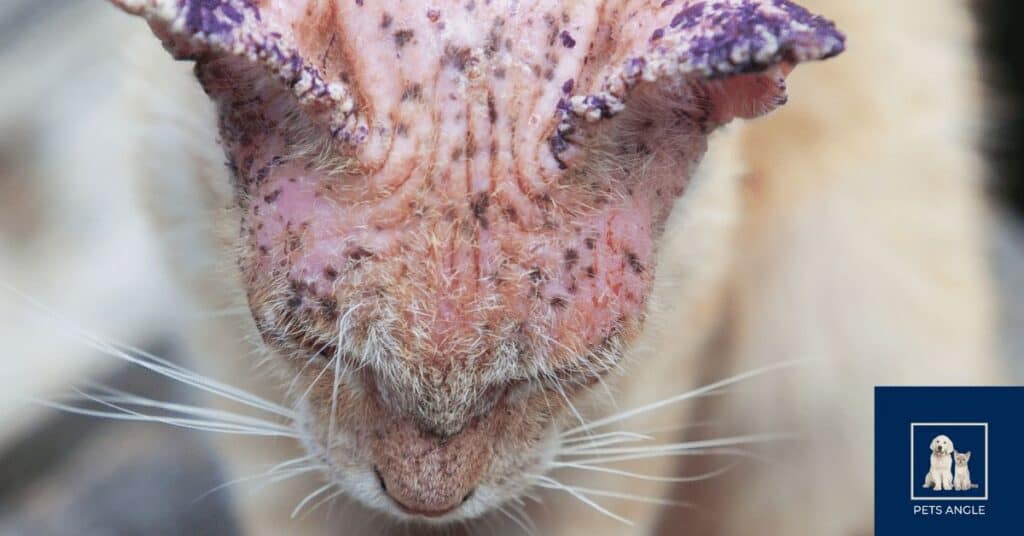Cat skin irritation scab is a reaction pattern affecting a cat’s skin, and the reaction looks like tiny millet seeds on the cat’s skin. Its common signs include rash appearing around the neck and head of the cat, going down its back and along its rump.
Skin irritation scabs in cats are also known as military eczema. Skin irritation scabs are one of the prevalent skin diseases in cats that vets refer to as Feline miliary dermatitis.
Therefore, skin irritation scabs in cats affect skin conditions, usually due to an allergic reaction. i.e., it is a skin allergy that manifests in various ways. It is also often referred to as military dermatitis as a general name.
So, if you have heard of feline eczema, the colorful and nonspecific “blotch,” and the highly descriptive “scabby cat disease, please note that all refer to cat skin scabs.
Excessive self-grooming can indicate skin scabs before its detection on the skin surface. When you notice your cat spends substantial time cleaning up itself with its mouth, this may signal skin disease.
The usual causes of skin infection in felines are louse, bugs, mites, and ticks.
Whether your cat is allergic to bug bites, fleas and other blood-sucking pests can lead to scabbing and bleeding after they bite your pet. If you notice scabs on your cat, immediately check your cat for any parasites.
Signs of Skin Irritation Scabs in Cats
Signs can, at times, depend on the cause. General signs are listed below:
1. Red, tiny crusty bump or rash or pimple-like wounds. It is commonly found around the back, belly, neck, head, and flanks.
2. Continuous and intense itching and scratching.
3. Grazed areas/Lesions and scabs on the skin because of scratching.
4. Excessive licking
5. Hair loss
6. Hair pulling
7. Thickened skin that is darker than the surrounding skin
8. sores and scabs may be found around its head and tail when the allergy
is food-related.
Causes of Feline Skin Irritation Scab
This skin ailment can arise in cats due to a variety of factors or some multiple:
- Flea bite hypersensitivity (most significant cause)
- Bacterial infections
- Cheyletiellosis mite
- Hormonal malfunction
- Allergies (food, inhalant, or food intolerance issues)
- Drug reaction
- Poor diet
- Mites
- Immune-mediated diseases (immune disorders)
- Ringworm
- Contact allergies (though unusual)
Cats in hot zones or verminous locations are more likely to get this skin ailment. This illness may emerge significantly more frequently in the warmer months in cold-winter settings.
Treatment of Cat Skin Irritation Scabs
Treatment of irritation scabs may not be as easy as often said on the surface as it may be challenging to identify the cause, and the skin can flare up.
Remove fleas from the cat’s habitat, which may help ease many symptoms. If the flea reappears, so will the allergic symptoms and blotches. Since kittens clean themselves regularly, live fleas are uncommon on their body.
If a food reaction or intolerance causes the cat’s skin condition, the pet parent will need to change the cat’s diet. The moment a food reaction has been established, it is critical that the cat is prevented from consuming the causal food.
Keep the cat indoors to prevent counterproductive organisms resulting in the skin condition relapse.
Give the cat any of the following treatments:
- Phenergan.
- Corticoid
- Skin-friendly ointments.
- Anti-itching shampoo
- Supplements containing fatty acids
Allergy shots for cats are controversial. The shots are used only for cats that are severely affected. The shots are not always successful in curing the condition.
Home Treatment of Cat Skin Irritation Scabs
Please know that allergic skin diseases expose cats to itches and may degenerate to inflammation. To overcome discomfort from the itches, the corticosteroids family is among the usual medical prescriptions at the start. However, you can do the following to address general cat skin diseases:
- Ensure you bathe the cat to minimize inflammation and relieve their skin surface.
- Regular brushing is also helpful in distributing the natural oils in your cat’s skin and removing dead skin.
- A soothing oatmeal bath or a rinse of vinegar diluted to one tablespoon vinegar per quart of warm water.
- Clean the wound and cover it adequately to dry up with time. Cortef (hydrocortisone) can be applied to the wound spot after drying off.
Healing and Recovery Process from Cat Skin Irritation Scabs
The most crucial stage is to assess the causal factor. Remove the factor from the felines’ surroundings or diet. The cat is going to be OK. Its coat will sprout, and its flesh will recover.
Because many reasons for dermatitis are allergic, the cat may require corticoid treatment sometimes to prevent flare-ups from becoming severe.
The cat’s allergies may worsen as it ages. A cat’s recovery may not be complete if they have been identified with many allergies. It is necessary to continue with treatment to keep skin responses and symptoms under control.

